Olga Russakovsky
D2D: Detector-to-Differentiable Critic for Improved Numeracy in Text-to-Image Generation
Oct 22, 2025Abstract:Text-to-image (T2I) diffusion models have achieved strong performance in semantic alignment, yet they still struggle with generating the correct number of objects specified in prompts. Existing approaches typically incorporate auxiliary counting networks as external critics to enhance numeracy. However, since these critics must provide gradient guidance during generation, they are restricted to regression-based models that are inherently differentiable, thus excluding detector-based models with superior counting ability, whose count-via-enumeration nature is non-differentiable. To overcome this limitation, we propose Detector-to-Differentiable (D2D), a novel framework that transforms non-differentiable detection models into differentiable critics, thereby leveraging their superior counting ability to guide numeracy generation. Specifically, we design custom activation functions to convert detector logits into soft binary indicators, which are then used to optimize the noise prior at inference time with pre-trained T2I models. Our extensive experiments on SDXL-Turbo, SD-Turbo, and Pixart-DMD across four benchmarks of varying complexity (low-density, high-density, and multi-object scenarios) demonstrate consistent and substantial improvements in object counting accuracy (e.g., boosting up to 13.7% on D2D-Small, a 400-prompt, low-density benchmark), with minimal degradation in overall image quality and computational overhead.
Actions as Language: Fine-Tuning VLMs into VLAs Without Catastrophic Forgetting
Sep 26, 2025Abstract:Fine-tuning vision-language models (VLMs) on robot teleoperation data to create vision-language-action (VLA) models is a promising paradigm for training generalist policies, but it suffers from a fundamental tradeoff: learning to produce actions often diminishes the VLM's foundational reasoning and multimodal understanding, hindering generalization to novel scenarios, instruction following, and semantic understanding. We argue that this catastrophic forgetting is due to a distribution mismatch between the VLM's internet-scale pretraining corpus and the robotics fine-tuning data. Inspired by this observation, we introduce VLM2VLA: a VLA training paradigm that first resolves this mismatch at the data level by representing low-level actions with natural language. This alignment makes it possible to train VLAs solely with Low-Rank Adaptation (LoRA), thereby minimally modifying the VLM backbone and averting catastrophic forgetting. As a result, the VLM can be fine-tuned on robot teleoperation data without fundamentally altering the underlying architecture and without expensive co-training on internet-scale VLM datasets. Through extensive Visual Question Answering (VQA) studies and over 800 real-world robotics experiments, we demonstrate that VLM2VLA preserves the VLM's core capabilities, enabling zero-shot generalization to novel tasks that require open-world semantic reasoning and multilingual instruction following.
The Impact of Coreset Selection on Spurious Correlations and Group Robustness
Jul 15, 2025Abstract:Coreset selection methods have shown promise in reducing the training data size while maintaining model performance for data-efficient machine learning. However, as many datasets suffer from biases that cause models to learn spurious correlations instead of causal features, it is important to understand whether and how dataset reduction methods may perpetuate, amplify, or mitigate these biases. In this work, we conduct the first comprehensive analysis of the implications of data selection on the spurious bias levels of the selected coresets and the robustness of downstream models trained on them. We use an extensive experimental setting spanning ten different spurious correlations benchmarks, five score metrics to characterize sample importance/ difficulty, and five data selection policies across a broad range of coreset sizes. Thereby, we unravel a series of nontrivial nuances in interactions between sample difficulty and bias alignment, as well as dataset bias and resultant model robustness. For example, we find that selecting coresets using embedding-based sample characterization scores runs a comparatively lower risk of inadvertently exacerbating bias than selecting using characterizations based on learning dynamics. Most importantly, our analysis reveals that although some coreset selection methods could achieve lower bias levels by prioritizing difficult samples, they do not reliably guarantee downstream robustness.
Dynamic Diffusion Schrödinger Bridge in Astrophysical Observational Inversions
Jun 11, 2025Abstract:We study Diffusion Schr\"odinger Bridge (DSB) models in the context of dynamical astrophysical systems, specifically tackling observational inverse prediction tasks within Giant Molecular Clouds (GMCs) for star formation. We introduce the Astro-DSB model, a variant of DSB with the pairwise domain assumption tailored for astrophysical dynamics. By investigating its learning process and prediction performance in both physically simulated data and in real observations (the Taurus B213 data), we present two main takeaways. First, from the astrophysical perspective, our proposed paired DSB method improves interpretability, learning efficiency, and prediction performance over conventional astrostatistical and other machine learning methods. Second, from the generative modeling perspective, probabilistic generative modeling reveals improvements over discriminative pixel-to-pixel modeling in Out-Of-Distribution (OOD) testing cases of physical simulations with unseen initial conditions and different dominant physical processes. Our study expands research into diffusion models beyond the traditional visual synthesis application and provides evidence of the models' learning abilities beyond pure data statistics, paving a path for future physics-aware generative models which can align dynamics between machine learning and real (astro)physical systems.
COMPACT: COMPositional Atomic-to-Complex Visual Capability Tuning
Apr 30, 2025Abstract:Multimodal Large Language Models (MLLMs) excel at simple vision-language tasks but struggle when faced with complex tasks that require multiple capabilities, such as simultaneously recognizing objects, counting them, and understanding their spatial relationships. This might be partially the result of the fact that Visual Instruction Tuning (VIT), a critical training step for MLLMs, has traditionally focused on scaling data volume, but not the compositional complexity of training examples. We propose COMPACT (COMPositional Atomic-to-complex visual Capability Tuning), which generates a training dataset explicitly controlling for the compositional complexity of the training examples. The data from COMPACT allows MLLMs to train on combinations of atomic capabilities to learn complex capabilities more efficiently. Across all benchmarks, COMPACT achieves comparable performance to the LLaVA-665k VIT while using less than 10% of its data budget, and even outperforms it on several, especially those involving complex multi-capability tasks. For example, COMPACT achieves substantial 83.3% improvement on MMStar and 94.0% improvement on MM-Vet compared to the full-scale VIT on particularly complex questions that require four or more atomic capabilities. COMPACT offers a scalable, data-efficient, visual compositional tuning recipe to improve on complex visual-language tasks.
Interactivity x Explainability: Toward Understanding How Interactivity Can Improve Computer Vision Explanations
Apr 14, 2025Abstract:Explanations for computer vision models are important tools for interpreting how the underlying models work. However, they are often presented in static formats, which pose challenges for users, including information overload, a gap between semantic and pixel-level information, and limited opportunities for exploration. We investigate interactivity as a mechanism for tackling these issues in three common explanation types: heatmap-based, concept-based, and prototype-based explanations. We conducted a study (N=24), using a bird identification task, involving participants with diverse technical and domain expertise. We found that while interactivity enhances user control, facilitates rapid convergence to relevant information, and allows users to expand their understanding of the model and explanation, it also introduces new challenges. To address these, we provide design recommendations for interactive computer vision explanations, including carefully selected default views, independent input controls, and constrained output spaces.
Attention IoU: Examining Biases in CelebA using Attention Maps
Mar 26, 2025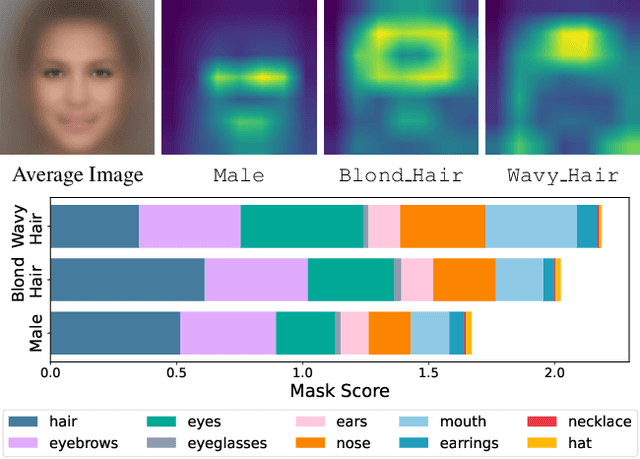
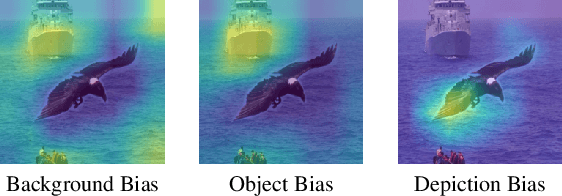

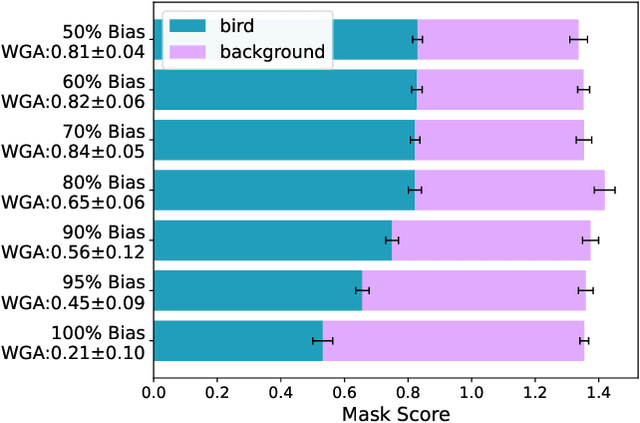
Abstract:Computer vision models have been shown to exhibit and amplify biases across a wide array of datasets and tasks. Existing methods for quantifying bias in classification models primarily focus on dataset distribution and model performance on subgroups, overlooking the internal workings of a model. We introduce the Attention-IoU (Attention Intersection over Union) metric and related scores, which use attention maps to reveal biases within a model's internal representations and identify image features potentially causing the biases. First, we validate Attention-IoU on the synthetic Waterbirds dataset, showing that the metric accurately measures model bias. We then analyze the CelebA dataset, finding that Attention-IoU uncovers correlations beyond accuracy disparities. Through an investigation of individual attributes through the protected attribute of Male, we examine the distinct ways biases are represented in CelebA. Lastly, by subsampling the training set to change attribute correlations, we demonstrate that Attention-IoU reveals potential confounding variables not present in dataset labels.
Fostering Appropriate Reliance on Large Language Models: The Role of Explanations, Sources, and Inconsistencies
Feb 12, 2025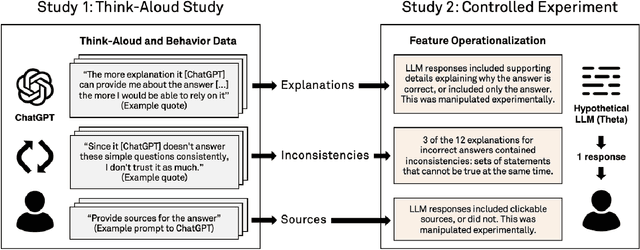
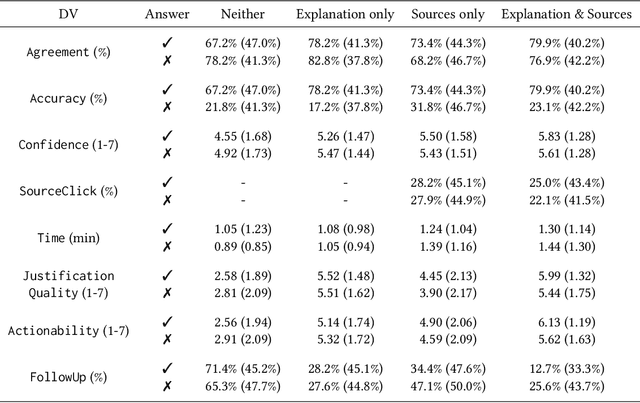
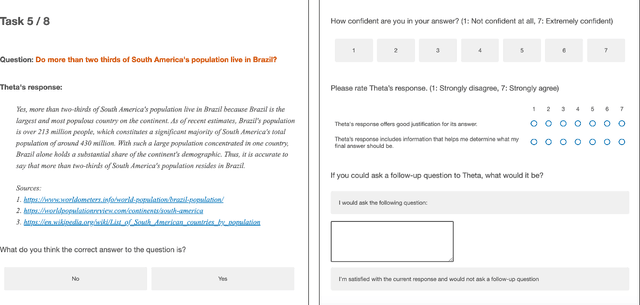
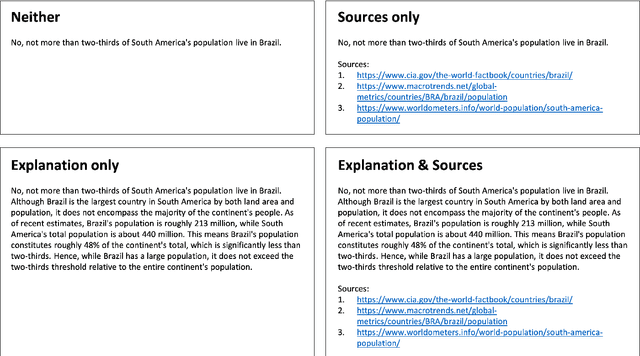
Abstract:Large language models (LLMs) can produce erroneous responses that sound fluent and convincing, raising the risk that users will rely on these responses as if they were correct. Mitigating such overreliance is a key challenge. Through a think-aloud study in which participants use an LLM-infused application to answer objective questions, we identify several features of LLM responses that shape users' reliance: explanations (supporting details for answers), inconsistencies in explanations, and sources. Through a large-scale, pre-registered, controlled experiment (N=308), we isolate and study the effects of these features on users' reliance, accuracy, and other measures. We find that the presence of explanations increases reliance on both correct and incorrect responses. However, we observe less reliance on incorrect responses when sources are provided or when explanations exhibit inconsistencies. We discuss the implications of these findings for fostering appropriate reliance on LLMs.
ICONS: Influence Consensus for Vision-Language Data Selection
Jan 06, 2025



Abstract:Visual Instruction Tuning typically requires a large amount of vision-language training data. This data often containing redundant information that increases computational costs without proportional performance gains. In this work, we introduce ICONS, a gradient-driven Influence CONsensus approach for vision-language data Selection that selects a compact training dataset for efficient multi-task training. The key element of our approach is cross-task influence consensus, which uses majority voting across task-specific influence matrices to identify samples that are consistently valuable across multiple tasks, allowing us to effectively prioritize data that optimizes for overall performance. Experiments show that models trained on our selected data (20% of LLaVA-665K) achieve 98.6% of the relative performance obtained using the full dataset. Additionally, we release this subset, LLaVA-ICONS-133K, a compact yet highly informative subset of LLaVA-665K visual instruction tuning data, preserving high impact training data for efficient vision-language model development.
Unifying Specialized Visual Encoders for Video Language Models
Jan 02, 2025



Abstract:The recent advent of Large Language Models (LLMs) has ushered sophisticated reasoning capabilities into the realm of video through Video Large Language Models (VideoLLMs). However, VideoLLMs currently rely on a single vision encoder for all of their visual processing, which limits the amount and type of visual information that can be conveyed to the LLM. Our method, MERV, Multi-Encoder Representation of Videos, instead leverages multiple frozen visual encoders to create a unified representation of a video, providing the VideoLLM with a comprehensive set of specialized visual knowledge. Spatio-temporally aligning the features from each encoder allows us to tackle a wider range of open-ended and multiple-choice video understanding questions and outperform prior state-of-the-art works. MERV is up to 3.7% better in accuracy than Video-LLaVA across the standard suite video understanding benchmarks, while also having a better Video-ChatGPT score. We also improve upon SeViLA, the previous best on zero-shot Perception Test accuracy, by 2.2%. MERV introduces minimal extra parameters and trains faster than equivalent single-encoder methods while parallelizing the visual processing. Finally, we provide qualitative evidence that MERV successfully captures domain knowledge from each of its encoders. Our results offer promising directions in utilizing multiple vision encoders for comprehensive video understanding.
 Add to Chrome
Add to Chrome Add to Firefox
Add to Firefox Add to Edge
Add to Edge